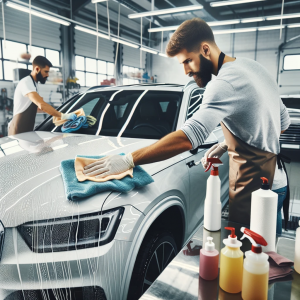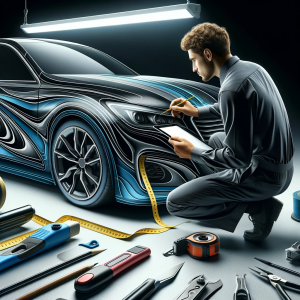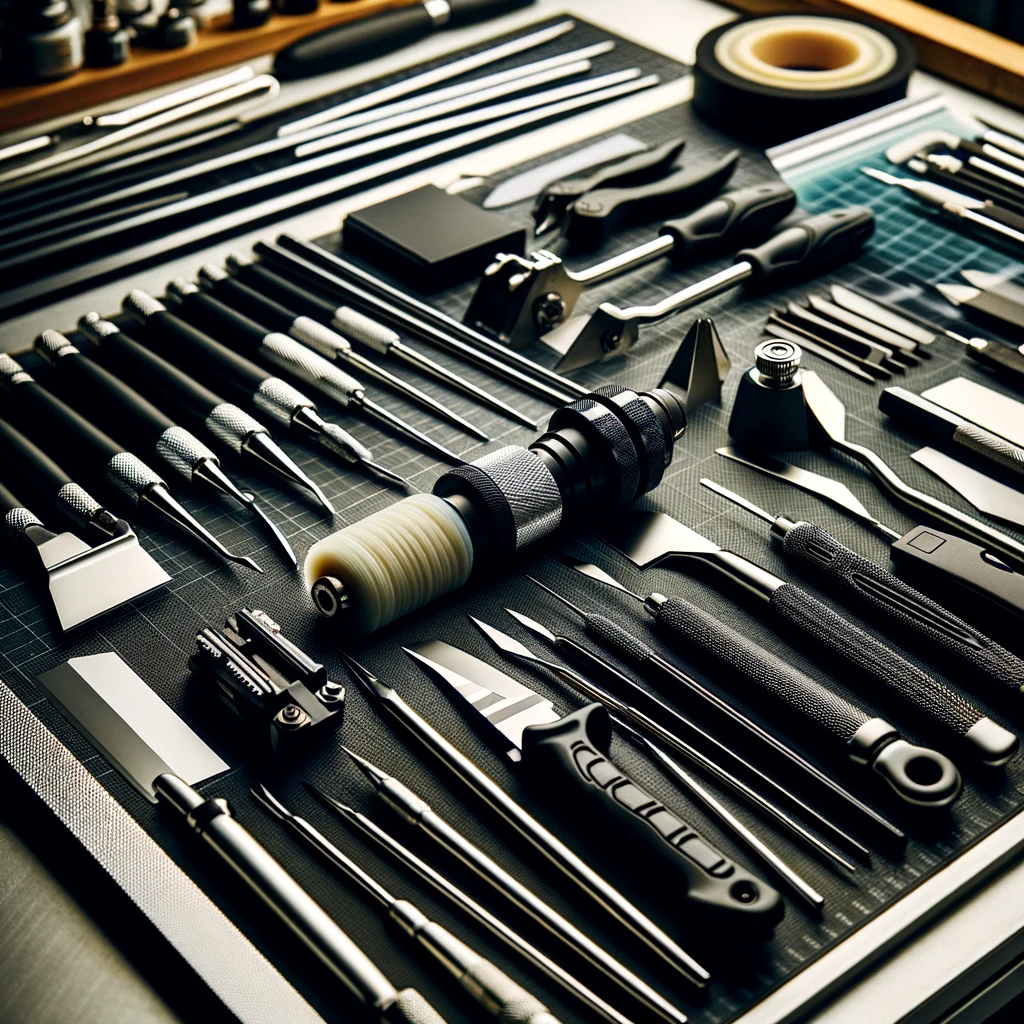“Manual vs. Machine PPF: A Detailed Installation Guide”
In the evolving world of automotive paint protection, the debate between manual cutting and machine precision for Paint Protection Film (PPF) installation remains at the forefront. Both methods have their merits and shortcomings, which we will explore in this comprehensive guide. Understanding these differences is crucial for both car owners and auto detailers seeking to protect vehicles while ensuring the highest quality of application.
**Manual Cutting: The Artisanal Approach – A Grueling Test of Skill and Patience**

Manual cutting of PPF is not just a process; it’s an art form that demands patience, skill, and an extraordinary attention to detail. Often involving a team of two or more technicians, this method turns the application of a protective film into a meticulous craft.
1. **Teamwork and Labor Intensity:** Unlike machine cutting, manual application often requires multiple hands. It’s not uncommon to have a team of two or three technicians working in tandem, especially for larger vehicles or complex shapes. Each member plays a crucial role – one measures and cuts, another applies and adjusts the film, and the third smooths out the film and trims the edges.
2. **Time-Consuming Process:** Manual cutting is a time sink. A typical sedan might take anywhere from four to six hours to cover, and for larger or more complex vehicles, that time can easily double. Every curve, edge, and corner adds to the application time, demanding unwavering concentration and steady hands throughout.
3. **Skill Level:** The level of expertise required for manual PPF application is significant. Technicians must have a deep understanding of vehicle contours and the characteristics of different PPF materials. They need to predict how the film will behave on curved surfaces and edges, requiring not just technical skill but also a form of intuition gained through experience.
4.In manual PPF application, the stakes are high and the pressure on technicians is intense. Each cut must be precise; a single misaligned application or an erroneous cut can lead to significant material waste, translating into substantial financial losses. For instance, in a high-end detailing shop, an error as small as a misjudged curve on a sports car's bumper can result in wasting a 3-foot section of premium film, which could mean a financial setback of nearly $300. This not only adds to the material costs but also prolongs the job completion time, further impacting the shop's efficiency and scheduling.
The cost of such mistakes is not just monetary. The psychological pressure of working with expensive materials where every inch counts can be a considerable stress factor for technicians. They are constantly balancing the need for speed with the demand for accuracy, a challenging task especially when dealing with complex vehicle models that have intricate designs. This pressure is omnipresent, regardless of the technician’s experience level. While seasoned professionals might navigate these challenges with more ease, the risk of costly errors is always present, making manual PPF application a demanding and high-stakes endeavor.
5. **Artisanal Craftsmanship:** In manual cutting, every vehicle is a unique project. Technicians often have to make on-the-spot decisions about how to handle specific areas of a car. This adaptability and problem-solving approach are what set manual application apart but also what makes it so challenging and labor-intensive.
In the world of PPF application, manual cutting is akin to walking a tightrope. It’s a balancing act of precision, speed, and efficiency, where the cost of a mistake is high and the demand for perfection is higher. For those who master this craft, the satisfaction of a job well done is immense – but it’s a path fraught with challenges and demands the utmost in skill and dedication.
**Machine Precision: The Technological Edge**

Machine cutting of PPF uses advanced software and plotting devices to cut the film precisely according to the vehicle's dimensions. This method has gained popularity due to its accuracy and efficiency. Here’s how it works:
1. **Vehicle Measurement and Software Input:** The specific make and model of the vehicle are inputted into a software system, which has a preloaded database of vehicle dimensions.
2. **Precision Cutting:** The machine precisely cuts the PPF according to the software's design, ensuring accurate, consistent coverage for each part of the vehicle.
3. **Preparation and Application:** Similar to manual application, the vehicle's surface is cleaned, and the pre-cut film is applied using a slip solution, squeegeed for adhesion, and finished off for a seamless fit.
The advantages of machine cutting are numerous. It offers consistency, reduces material waste, and is generally faster than manual application. The precision of machine cutting ensures perfect alignment and coverage, which is particularly beneficial for newer vehicle models with complex curves and edges.
**Why Machine Cutting is Essential**

In the competitive landscape of automotive care, efficiency and precision are paramount. Machine cutting represents a significant advancement in PPF application. It not only reduces the margin for error but also enables a faster turnaround time, which is beneficial for both businesses and their clients. Moreover, with the advancement in software technology, the accuracy of machine cutting has reached a level that manual methods can rarely match.
The cost-effectiveness of machine cutting is also a crucial factor. By minimizing waste and reducing the need for reworks, businesses can save on material costs and pass these savings onto their customers. In addition, the uniformity and quality of machine-applied PPF often translate to higher customer satisfaction and repeat business.
**Conclusion**
hile manual cutting of PPF has its place in the industry, particularly for custom or classic cars, the benefits of machine cutting are undeniable for the majority of modern vehicles. Its precision, efficiency, and consistency make it an indispensable tool in the arsenal of any auto detailing business. As technology continues to advance, embracing machine precision in PPF application is not just a trend – it’s a necessity for staying competitive and delivering the best results to clients.
This detailed guide aims to provide valuable insights into the world of PPF application, helping businesses and car enthusiasts make informed decisions about protecting their vehicles. Embracing technology in automotive care is not just about following the latest trend; it’s about ensuring the highest quality and satisfaction for every car that rolls out of your shop.
Post time: Nov-20-2023




